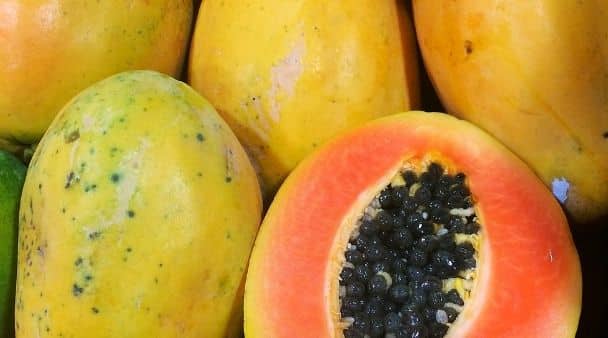Papaya in Costa Rica: From Kitchen Staple to Culinary Secret Weapon
Costa Rica is a place where volcano hikes meet sunset surf, where marimba music drifts across plazas and start-ups share the spotlight with eco-lodges. It’s a country that sells lifestyle as much as landscape: adventures before breakfast, wildlife at the window, real estate with rainforest views, a business scene that cares about purpose, and food that tastes like sunshine. At the heart of that flavour is papaya — the orange-fleshed, honey-scented fruit that shows up at breakfast tables, street stalls, chef tastings and even in clever kitchen hacks you’ll want to steal.
What makes papaya central to Costa Rican life?
Papaya is both an everyday fuel and festive flavour in Costa Rica.
It’s grown widely in warm coastal belts, stars in market fruit cups, anchors light breakfasts with lime, and slips into savoury dishes like ceviche or casados without fuss.
Why locals love it
-
Year-round availability – Coastal heat and humidity keep the fruit coming.
-
Versatility – Works fresh, roasted, pickled, blended, or spiced.
-
Value – Affordable, abundant, and low-waste (even the seeds can be used).
Where does papaya come from and how does it grow?
Papaya (Carica papaya) is native to the tropical Americas and thrives in Costa Rica’s coastal climates.
Plants shoot up fast (small trees can reach 9 metres), with big lobed leaves, small yellow-pink flowers, and oval fruit that ripens from green to golden.
Growing essentials
-
Sun + water: Full sun and regular watering keep plants productive.
-
Soils: Free-draining soils prevent root issues.
-
Spacing: Good airflow reduces disease pressure.
What does great papaya taste like — and how do you pick one?
Ripe papaya tastes softly sweet with melon-like perfume and a custardy texture.
Choose fruit that yields slightly to gentle pressure, smells fragrant at the stem, and shows golden skin with minimal blemishes.
Buying & storing tips
-
For today: Go for mostly yellow skin; eat within 1–2 days.
-
For later: Buy greener, let ripen at room temperature, then chill cut pieces.
Can you eat papaya seeds and peel?
You can eat the seeds and use the peel for clever cooking techniques.
Seeds have a peppery kick; the peel can serve as a marinating “pod” or roasting shell, adding aroma and moisture.
How to use the “extras”
-
Seeds = “pepper”: Dry or air-fry on low, grind, and use like a citrusy pepper.
-
Peel as cradle: Roast fruit in its skin to catch caramelising juices; for meat, it can act as a tenderising sheath.
What are the health benefits of papaya?
Papaya supports digestion and immunity while adding antioxidant power.
It contains papain (a digestive enzyme), vitamin C, vitamin A precursors, and anti-inflammatory compounds that make it a smart daily choice.
At-a-glance perks
-
Digestion: Enzymes help break down proteins.
-
Immunity & skin: Vitamin C contributes to collagen and defence.
-
Light + hydrating: High water content and gentle sweetness.
What challenges do papaya farmers face in Costa Rica?
Papaya ringspot virus remains the main headache for growers.
It can devastate yields, so farmers and scientists focus on hygiene, resistant varieties, and orchard management to keep the industry resilient.
Typical responses
-
Rogue & replace: Remove infected plants quickly.
-
Vector control: Manage sap-feeding insects that spread disease.
-
Diversity: Mix plantings and rotate sites to reduce risk.
How do Costa Ricans cook with papaya?
Papaya plays sweet and savoury roles across home kitchens, sodas (local diners), and chef menus.
From zesty breakfasts to char-kissed desserts and even beef that melts after a papaya assist, the range is huge.
Everyday favourites (with quick descriptions)
-
Fresh with lime: A squeeze of lime sharpens sweetness and perfumes each bite.
-
Ceviche add-in: Diced papaya brings gentle sweetness to balance citrus and chilli.
-
Casado garnish: Light, juicy counterpoint to rice, beans and grilled meats.
-
Batidos (smoothies): Silky texture makes blender drinks taste luxurious.
-
Encurtido (pickled): Green papaya pickles hold crunch and take on spice beautifully.
Featured Papaya Recipes You’ll Actually Cook
Roasted Papaya with Brown Sugar & Ginger (Oven Method, 35–40 minutes)
Roasting concentrates sweetness and perfumes the kitchen.
You’ll need: 2 medium Solo papayas (halved, seeded), 2 tbsp light-brown sugar, ¼ tsp ground ginger, ¼ tsp cayenne, 1 lime (wedges).
Method (explained):
-
Heat & mix: Preheat to 230°C/450°F; stir sugar and ginger so every sprinkle tastes spicy-sweet.
-
Arrange: Halves cut-side up in a snug baking dish to catch juices.
-
Roast: 35–40 minutes, brushing edges with the bubbling syrup to lacquer and darken them.
-
Finish: A whisper of cayenne and a lime squeeze to wake the sugars.
Sous Vide Papaya Flat Iron Steak (Ridiculously Tender)
Papaya’s enzymes + sous vide turn tougher cuts silky.
Steps (why they matter):
-
Papaya “pod”: Fit trimmed flat iron inside a scraped papaya skin; this keeps papain close to the meat without flooding it.
-
Chill infuse: 4–5 hours in the fridge develops gentle tenderisation.
-
Sous vide: 57°C/135°F for 2 hours ensures edge-to-edge doneness.
-
Sear hard: Quick cast-iron or parrillada char for flavour.
-
Slice thin: 6–12 mm slices highlight tenderness.
Simple Roasted Papaya (Dessert or Side)
Minimal effort, maximum caramel.
How-to (with reasons):
-
Split lengthwise: Like squash, to expose more surface for browning.
-
Top & baste: Brown sugar + powdered ginger form a glossy glaze that you spoon back over for deeper colour.
-
Bake: Until edges take on toastiness; serve as a pudding with yoghurt or alongside roast pork.
“Touch of Lime” Fresh Papaya (Five-Second Upgrade)
Lime is the only garnish you need.
Why it works: Acid tightens flavours, cuts richness, and adds fragrance — perfect for breakfast bowls or palate cleansers.
Papaya-Seed “Pepper” (Zero-Waste Spice)
Dry the seeds, blitz, and use like pepper.
Why you’ll love it: It’s citrusy, slightly bitter, and brilliant on grilled fish, mango salads, or avocado toast.
Quick Ideas to Try Tonight
-
Papaya-mint salad: Papaya, cucumber, mint, chilli, lime, pinch of salt — cooling and bright.
-
Green papaya slaw: Julienned green papaya with tamarind, fish sauce, and roasted peanuts for a crunchy side.
-
Breakfast bowl: Papaya boats filled with yoghurt, granola, and a drizzle of honey.
-
Grill-marked wedges: Brush with neutral oil, grill to light char, finish with sea salt and chilli.
FAQ
Is papaya good for sensitive stomachs?
Yes — papain can support protein digestion, though anyone with latex/fruit allergies should check tolerance.
Can I eat green (unripe) papaya?
Yes — it’s brilliant shredded in salads or pickled; it holds crunch and soaks up dressings.
How do I stop papaya smelling too musky?
A squeeze of lime or a pinch of salt cuts musk and sharpens aroma immediately.
What meats pair best with papaya tenderising?
Flat iron, flank and skirt respond beautifully; keep contact time modest to avoid mushiness.
How long does cut papaya last?
In the fridge, 2–3 days in an airtight container; add a squeeze of lime to keep flavours lively.
More related articles:







